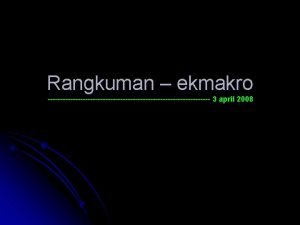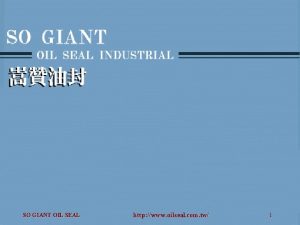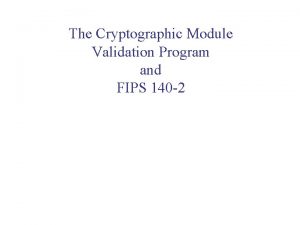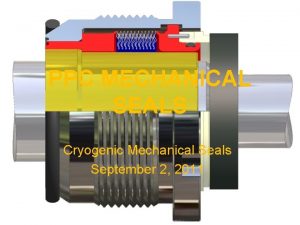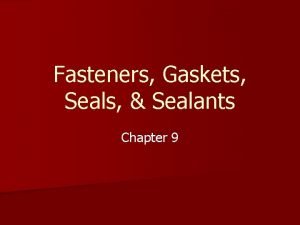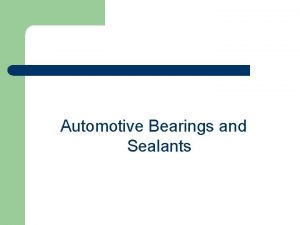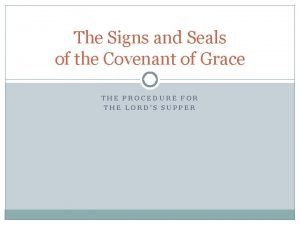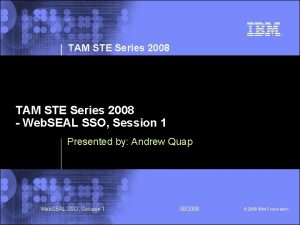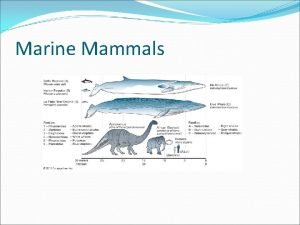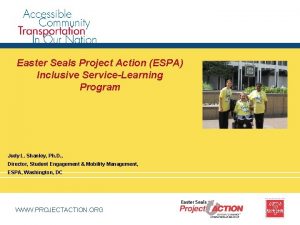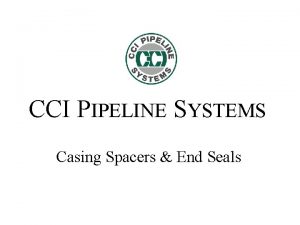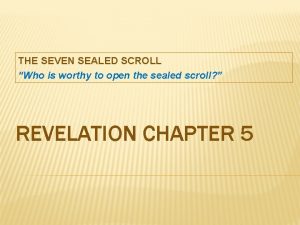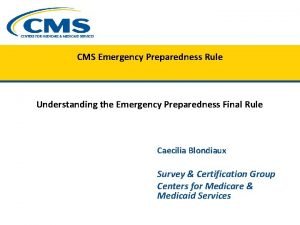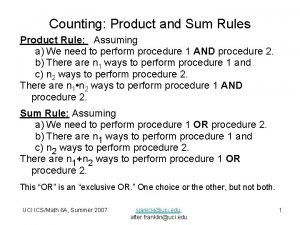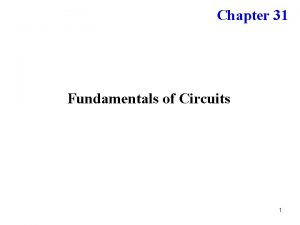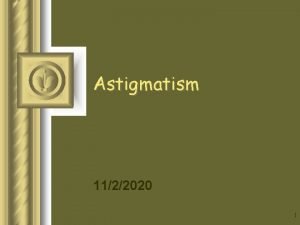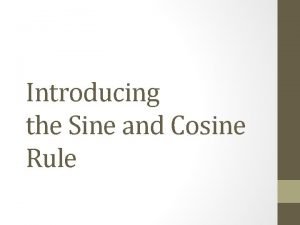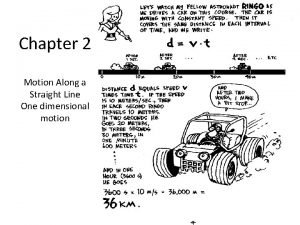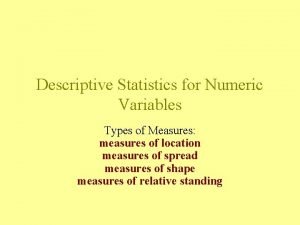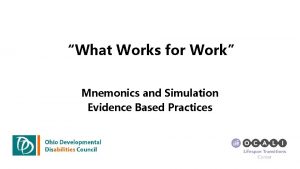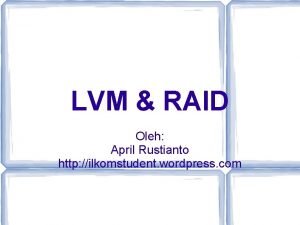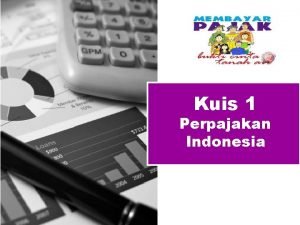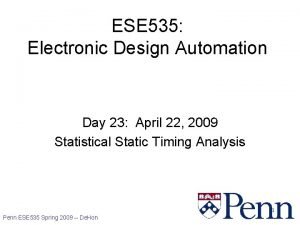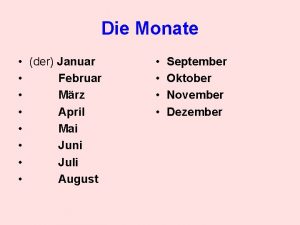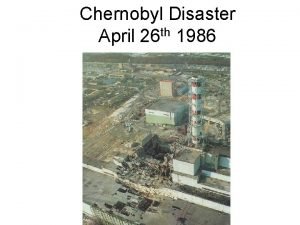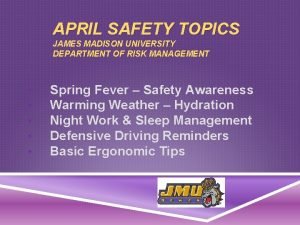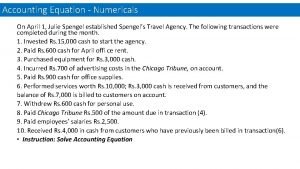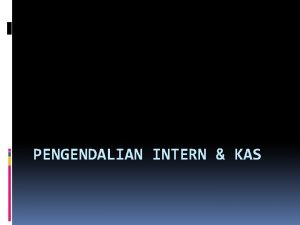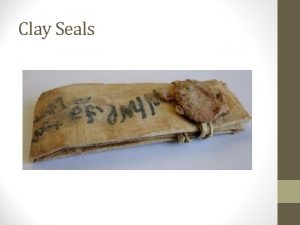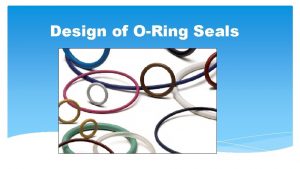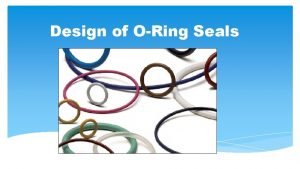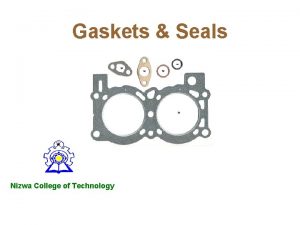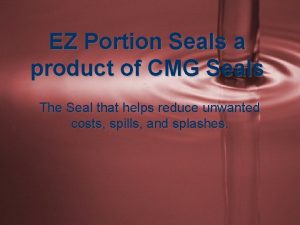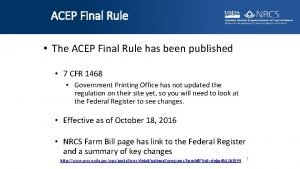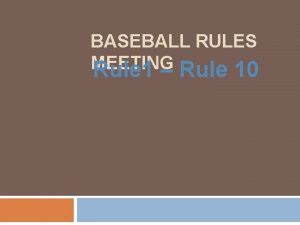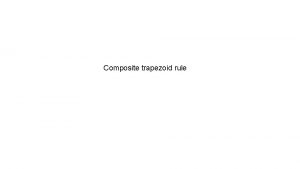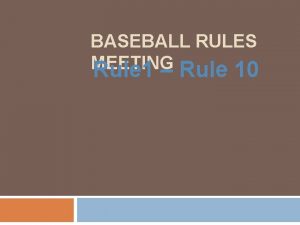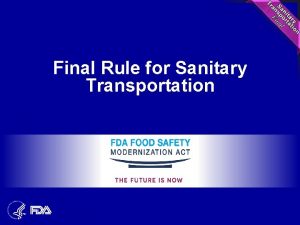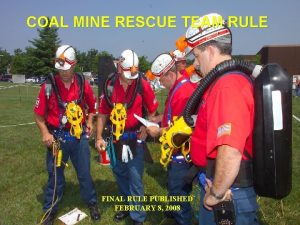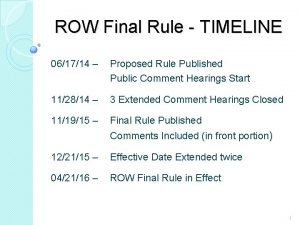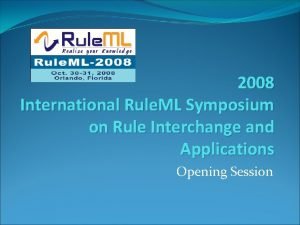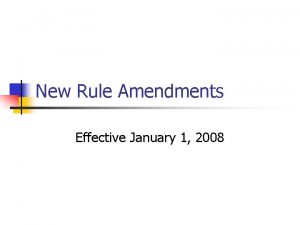Final Rule SEALS April 18 2008 Overview 75






































































- Slides: 70

Final Rule SEALS April 18, 2008

Overview § 75. 335 Seal Strengths, Design Applications, and Installation n § 75. 336 Sampling and Monitoring Requirements n § 75. 337 Construction and Repair of Seals n § 75. 338 Training n § 75. 339 Seal Records n

§ 75. 335 Seal Strengths, Design Applications, and Installation

§ 75. 335 Seal Strengths, Design Applications, and Installation – (a) Seals constructed on or after October 20, 2008 shall be designed, constructed, and maintained to withstand n (1)(i) 50 PSI when atmosphere monitored and maintained inert. Instantaneous rate of rise

§ 75. 335 Seal Strengths, Design Applications, and Installation Instantaneous rate of rise § Good for all 50 PSI Seals § Characterizes duration and intensity § More prescriptive approach eliminates ambiguity

§ 75. 335 Seal Strengths, Design Applications, and Installation – (ii) 50 PSI – Active longwall panel. Rate of rise 0. 1 second

§ 75. 335 Seal Strengths, Design Applications, and Installation Longwall panel seals only § 50 PSI Seals § Explosion having pressure venting and slower pressure rise times § Smaller run up distances

§ 75. 335 Seal Strengths, Design Applications, and Installation n (2)(i) 120 PSI when atmosphere not monitored and not maintained inert. Instantaneous rate of rise

§ 75. 335 Seal Strengths, Design Applications, and Installation Instantaneous rate of rise § Good for all 120 PSI Seals § Characterizes duration and intensity § More prescriptive approach eliminates ambiguity

§ 75. 335 Seal Strengths, Design Applications, and Installation § (ii) 120 PSI – Active longwall panel. Rate of rise 0. 25

§ 75. 335 Seal Strengths, Design Applications, and Installation Longwall panel seals only § 120 PSI Seals § Explosion having pressure venting and slower pressure rise times § Smaller run up distances

§ 75. 335 Seal Strengths, Design Applications, and Installation n (3) Greater than 120 PSI when atmosphere not monitored and not maintained inert. – (i) Homogeneous mixtures of methane between 4. 5 and 17% and oxygen exceeded 17% throughout entire area,

§ 75. 335 Seal Strengths, Design Applications, and Installation – (ii) Pressure piling could result in pressures greater than 120 PSI, or – (iii) Other conditions, such as a detonation. – (iv) When (i), (ii), or (iii), ventilation plan must address potential hazards including seal strengths.

§ 75. 335 Seal Strengths, Design Applications, and Installation – (b) Seal design applications submitted to Technical Support for approval – engineered or explosion tested or equivalent. n (1) Engineering design applications shall: – (i) Address sampling pipes, …. , elasticity of design, …other information related to seal construction;

§ 75. 335 Seal Strengths, Design Applications, and Installation Elasticity of design § § 120 PSI or greater design must withstand repeated, independent overpressures. Consistent with current prudent engineering practices.

§ 75. 335 Seal Strengths, Design Applications, and Installation – (ii) Be certified by a professional engineer; – (iii) Include a summary of the installation procedures related to seal construction; or

§ 75. 335 Seal Strengths, Design Applications, and Installation Summary of installation procedures § § All of the information necessary to construct a seal including quality control. Material testing by a certified laboratory (such as ISO) and by qualified personnel.

§ 75. 335 Seal Strengths, Design Applications, and Installation n (2) Applications based on full-scale explosion tests or equivalent means of physical testing shall…: – (i) Be certified by a professional engineer; – (ii) Information related to methods and materials;

§ 75. 335 Seal Strengths, Design Applications, and Installation Equivalent means of physical testing § Such as suitable hydrostatic test chambers similar to those at NIOSH’s Lake Lynn Mine.

§ 75. 335 Seal Strengths, Design Applications, and Installation – (iii) Supporting documentation; – (iv) Analysis to address differences between test conditions and coal mine conditions; – (v) Include a summary of the installation procedures related to seal construction.

§ 75. 335 Seal Strengths, Design Applications, and Installation n (3) MSHA can require additional information or testing n (4) MSHA will notify of approval or denial n (5) Notification of future deficiencies

§ 75. 335 Seal Strengths, Design Applications, and Installation – (c) The installation of the approved design shall be subject to approval in ventilation plan. The mine operator shall – n (1) Retain approval and installation information; n (2) Designate a PE to conduct or have oversight of installation and certify the approved design applicable to mine conditions;

§ 75. 335 Seal Strengths, Design Applications, and Installation PE to conduct or have oversight of installation – Same as ETS § Verify seal application is suitable for specific conditions, § Confirm the site preparation is adequate, § Confirm that the workforce is adequately trained,

§ 75. 335 Seal Strengths, Design Applications, and Installation PE to conduct or have oversight of installation – Same as ETS § Verify the correct materials and procedures are being used, § Confirm adequate quality controls are in place, § Does not have to be onsite the entire time seals are being constructed.

§ 75. 335 Seal Strengths, Design Applications, and Installation n (3) Provide the following information for approval in the Ventilation Plan – (i) Technical Support Approval Number; – (ii) Summary of installation procedures;

§ 75. 335 Seal Strengths, Design Applications, and Installation Summary of installation procedures § This information will be included in the approved design and available on MSHA’s website or from the seal designer.

§ 75. 335 Seal Strengths, Design Applications, and Installation – (iii) Mine Map, showing deepest penetration. Certified by Professional Engineer or Professional Land Surveyor;

§ 75. 335 Seal Strengths, Design Applications, and Installation Mine map including the deepest points of penetration. Map certified by PE or PLS. § § Assure that the sealed area was surveyed and a map was completed. Map can be certified by a PE or a Professional Land Surveyor.

§ 75. 335 Seal Strengths, Design Applications, and Installation – (iv) Specific mine site information; n (A) Seal Type, n (B) Safety precautions prior to seal achieving design strength, n (C) Site specific conditions, including set back distance, n (D) Site preparation, n (E) Sequence of installation, n (F) Projected date of completion,

§ 75. 335 Seal Strengths, Design Applications, and Installation Set-back distances; § Distance from the corner of a pillar block to the seal, § Critical to long term stability, § Included in design applications, § 10 feet in most instances.

§ 75. 335 Seal Strengths, Design Applications, and Installation n (G) Supplemental roof support, n (H) Water flow and drainage system, n (I) Methods to ventilate seals, n (J) Methods and materials to maintain seals, n (K) Methods to address shafts and boreholes,

§ 75. 335 Seal Strengths, Design Applications, and Installation Assessment of potential for overpressures greater than 120 PSI in sealed area, n (L) n (M) Additional sampling locations, n (N) Additional information required by the District Manager.

§ 75. 335 Seal Strengths, Design Applications, and Installation Assessment of potential for overpressures greater than 120 PSI in sealed area; § Homogeneous atmosphere exists: § Sample and appropriate number of locations, such as seals, boreholes, shafts, § If all samples show methane stabilized between 4. 5 and 17% and oxygen above 17%, the atmosphere is considered homogeneous.

§ 75. 335 Seal Strengths, Design Applications, and Installation § Pressure piling with pressures in excess of 120 PSI; § Evaluate physical characteristics to cause overpressures to exceed 120 PSI. § Example where the sealed area had been mined to height of nearly 20 feet but changed to only 7 feet near the seals.

§ 75. 335 Seal Strengths, Design Applications, and Installation § Detonation: § Evaluate ignition sources, § High energy ignition sources § Potential methane concentrations, § Extensive volumes of homogeneous mixtures § Potential oxygen concentrations. § Sufficient oxygen

§ 75. 336 Sampling and Monitoring Requirements

§ 75. 336 Sampling and Monitoring Requirements n (a) Certified person shall monitor atmosphere in sealed areas, whether ingassing or outgassing, for methane and oxygen and the direction of leakage. Seals shall be designed, constructed, and maintained. – (1) Each sampling pipe and approved location shall be sampled at least every 24 hours.

§ 75. 336 Sampling and Monitoring Requirements Atmospheres with seals of 120 PSI or greater shall be sampled until the design strength is reached for each seal. n (i)

§ 75. 336 Sampling and Monitoring Requirements Atmospheres with seals less than 120 PSI constructed before October 20, 2008 shall be monitored and maintained inert. n (ii) – The operator may request different locations and frequencies in the ventilation plan – one sample/set of seals/seven days.

§ 75. 336 Sampling and Monitoring Requirements Atmospheres with seals less than 120 PSI constructed after October 20, 2008 shall be monitored and maintained inert. n (iii) – The operator may request different locations and frequencies in the ventilation plan after a minimum of 14 days and the seal design strength is reached – one sample/set of seals/seven days.

§ 75. 336 Sampling and Monitoring Requirements – (2) The mine operator shall evaluate the atmosphere in the sealed area to determine whether sampling through sampling pipes and approved locations provides appropriate sampling locations.

§ 75. 336 Sampling and Monitoring Requirements § immediately after the 14 day sampling, if the ventilation system is reconfigured, § if changes occur that adversely affect the sealed area, or § if the District Manager requests an evaluation. §

§ 75. 336 Sampling and Monitoring Requirements – If needed, the mine operator shall provide the additional locations and have them approved in the ventilation plan. The District manager may require additional locations and frequencies.

§ 75. 336 Sampling and Monitoring Requirements – (3) Mine operators with an approved ventilation plan addressing spontaneous combustion plan shall sample the sealed atmosphere in accordance with the ventilation plan. – (4) The District Manager may approve the use of a continuous monitoring system in lieu of the monitoring provisions.

§ 75. 336 Sampling and Monitoring Requirements n (b)(1) The atmosphere in the sealed area is considered inert when oxygen less than 10. 0% or the methane is less than 3% or greater than 20. 0%.

§ 75. 336 Sampling and Monitoring Requirements – (2) Immediate action shall be taken to restore an inert atmosphere behind seals less than 120 PSI. n Until the atmosphere is restored, the sealed atmosphere should be monitored at each sampling pipe and approved location at least once every 24 hours.

§ 75. 336 Sampling and Monitoring Requirements n (c) When the atmosphere in the sealed area with seals less than 120 PSI is 10% or greater oxygen and the methane is between 4. 5% and 17. 0%, – the mine operator shall immediately take an additional sample and , – notify the District Manager.

§ 75. 336 Sampling and Monitoring Requirements n When the additional sample indicates 10% or greater oxygen and the methane is between 4. 5% and 17. 0%, – persons shall be withdrawn from the affected area which is the entire mine, n or other affected area identified by the operator and approved by the District Manager, except those referred to in 104(c) of the Act.

§ 75. 336 Sampling and Monitoring Requirements n The operators may identify areas in the ventilation plan where persons may be exempt from withdrawal. They shall address the location of seals in relation to: – Areas persons work or travel; – Escapeways and potential for damage to escapeways;

§ 75. 336 Sampling and Monitoring Requirements n – Ventilation systems and controls in areas where person work or travel ; and – Where ventilation is used for escapeways. The operators request shall also address the gas concentration of other sampling locations and other required information.

§ 75. 336 Sampling and Monitoring Requirements n Before miners reenter the mine, the mine operator shall have a ventilation plan revision approved by the District Manager specifying the actions to be taken.

§ 75. 336 Sampling and Monitoring Requirements n (d) In sealed areas with a demonstrated history of carbon dioxide or sealed areas where inert gases have been injected, the operator may request that the District Manager approve an alternative method to determine if the sealed area is inert and when miners have to be withdrawn.

§ 75. 336 Sampling and Monitoring Requirements The mine operator shall address: § The specific levels of methane, carbon dioxide, nitrogen and oxygen; § The sampling methods and equipment used; § The methods to evaluate these concentrations underground at the seal. n

§ 75. 336 Sampling and Monitoring Requirements n (e) The certified person shall record the sampling result including: The location of the sampling point; Whether ingassing or outgassing; And oxygen and methane concentration as a percentage; and Any hazardous condition in accordance with 75. 363.

§ 75. 337 Construction and Repair of Seals

§ 75. 337 Construction and Repair of Seals – (a) The mine operator shall maintain and repair seals to protect miners, – (b) Prior to sealing, the mine operator shall: n (1) Remove insulated cables, batteries, and other potential electric ignition sources, unless it is not safe to do so. If ignition sources cannot safely be removed, seals must be constructed to at least 120 PSI,

§ 75. 337 Construction and Repair of Seals n (2) Remove metal through or across seals; and n (3) Breach or remove all stoppings in the first crosscut inby the seals prior to sealing the area.

§ 75. 337 Construction and Repair of Seals – (c) Certified person shall directly supervise seal construction and repair and; n (1) Examine each seal site prior to construction and repair, n (2) Examine each seal under construction or repair each shift, n (3) Examine each seal upon completion of construction, n (4) Certify by initials, date and time, n (5) Make a record of the examination. Must be countersigned.

§ 75. 337 Construction and Repair of Seals – (e) Upon completion of construction, a senior mine management official shall certify the construction, installation, and materials used were in accordance with the approved ventilation plan.

§ 75. 337 Construction and Repair of Seals – ( d) The mine operator shall n (1) Notify District Manager 2 to 14 days prior to construction, n (2) Notify District Manager within 5 days of completion. Provide a copy of the certification by senior official, n (3) Submit quality control results.

§ 75. 337 Construction and Repair of Seals – (f) Welding, cutting, and soldering are prohibited within 150 feet of a seal. The operator may request a different location. The request must address: n methods used to continuously monitor in the sealed area, n the airflow conditions,

§ 75. 337 Construction and Repair of Seals n the rock dust and water application methods, n fire extinguishers, n procedures to maintain safe conditions, and n other relevant factors.

§ 75. 337 Construction and Repair of Seals – (g)(1)One non-metallic sampling pipe shall be installed in each seal that shall extend into the center of the first connecting crosscut. If an open crosscut does not exist, the pipe shall extend one-half the distance of the open entry.

§ 75. 337 Construction and Repair of Seals – (2) Each sampling pipe shall have a shut off valve and fitting for taking samples. – (3) The sampling pipes shall be labeled when there is more than one.

§ 75. 337 Construction and Repair of Seals – (4) If a new seal is constructed to replace an existing seal with a sample pipe, the sample pipe shall be extended through the new seal. An additional pipe shall be installed to sample the area between the two seals.

§ 75. 337 Construction and Repair of Seals (h) The seal at the lowest elevation shall have a corrosion-resistant , non-metallic water drainage system. Seals shall not impound water or slurry. Water or slurry shall not accumulate within the sealed area to any depth that can adversely affect a seal.

§ 75. 338 Training

§ 75. 338 Training – (a) Certified persons shall be trained in the use of sampling equipment, procedures, location of sampling points, frequency, size and condition of the sealed area, and the use of the continuous monitoring system and annually thereafter. – (b) Miners constructing or repairing seals, designated certified persons, and senior mine officials shall be trained prior to constructing or repairing a seal and annually thereafter.

§ 75. 339 Seal Records

§ 75. 339 Seal records – (a) Table of required records. – (b) Retention of records. n Electronic recordkeeping permitted. – (c) Access to records. n MSHA, HHS, Authorized representative of miners. – (d) Transfer of record to new operator.
 3 april 2008
3 april 2008 2008 2008
2008 2008 Shark and seal organism that is benefited
Shark and seal organism that is benefited Sogiant seals
Sogiant seals Heritage swim club
Heritage swim club Easter seals pei
Easter seals pei Chapter 8 fasteners gaskets seals and sealants
Chapter 8 fasteners gaskets seals and sealants Fips 140-1
Fips 140-1 Stop clubbing baby seals punctuation
Stop clubbing baby seals punctuation Ppc mechanical seals
Ppc mechanical seals Fasteners gaskets seals and sealants
Fasteners gaskets seals and sealants 3 types of sealants used in automotive
3 types of sealants used in automotive Signs and seals of the covenant
Signs and seals of the covenant What are the 7 bowls
What are the 7 bowls Red seals sso
Red seals sso Alan seals weather
Alan seals weather Characteristics of marine mammals
Characteristics of marine mammals Easter seals project action
Easter seals project action Cci casing spacers
Cci casing spacers The first seal
The first seal Sealed scroll
Sealed scroll Harp seals life cycle
Harp seals life cycle Edlt cdl
Edlt cdl Cms emergency preparedness final rule
Cms emergency preparedness final rule Magic triangle trig
Magic triangle trig Sine rule for obtuse triangles
Sine rule for obtuse triangles Soh cah toa rules
Soh cah toa rules Kirchhoffs junction rule
Kirchhoffs junction rule Product sum rule
Product sum rule Home rule vs dillon's rule
Home rule vs dillon's rule What is loop rule
What is loop rule Bi oblique astigmatism
Bi oblique astigmatism Simple hyperopic astigmatism example
Simple hyperopic astigmatism example What is with the rule and against the rule astigmatism
What is with the rule and against the rule astigmatism What is the cold chain rule
What is the cold chain rule General power rule
General power rule When to use the sine rule
When to use the sine rule Chain rule power rule
Chain rule power rule Leptokurtotic
Leptokurtotic William shakespeare born and death
William shakespeare born and death April 23rd 1616
April 23rd 1616 30 days has september april june and november
30 days has september april june and november April school activities
April school activities 23 april 1564
23 april 1564 April savoy allstate
April savoy allstate Sabbath day calendar
Sabbath day calendar Vårmåneder
Vårmåneder April rustianto
April rustianto Leonardo de vinci was born on april 15
Leonardo de vinci was born on april 15 Leonardo da vini
Leonardo da vini Reformdjp/quiz/kuis-mini-reformasi-perpajakan-mei-2022
Reformdjp/quiz/kuis-mini-reformasi-perpajakan-mei-2022 Institutional calendar
Institutional calendar Guten morgen freitag 1 april
Guten morgen freitag 1 april April bjornsen
April bjornsen 20 april 1889 day
20 april 1889 day 535 days before 23 april
535 days before 23 april April ericsson
April ericsson Dreißig tage hat september
Dreißig tage hat september Januar februar märz april
Januar februar märz april Site:slidetodoc.com
Site:slidetodoc.com April 2006 calendar
April 2006 calendar How to read p
How to read p Bondservants motorcycle
Bondservants motorcycle Adolf hitler kindheit
Adolf hitler kindheit Falske computer timeshare company
Falske computer timeshare company 22 april is celebrated as
22 april is celebrated as School calendar 2005-2006
School calendar 2005-2006 April 23 1616
April 23 1616 2003 april 20
2003 april 20 Pada tanggal 1 april 2011 cv seneng makmur
Pada tanggal 1 april 2011 cv seneng makmur The day the dancers came
The day the dancers came
